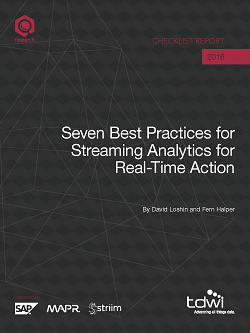
TDWI Checklist Report | Seven Best Practices for Streaming Analytics for Real-Time Action
July 21, 2016
Increasingly, organizations are realizing that analyzing data in motion—data that arrives continuously as a sequence of instances—can provide substantial business value. This data
comes from sensors, IoT devices, social media feeds, traffic feeds, and much more. The proliferation of real-time data streams coupled with the ability to ingest, process, and analyze that data, sets the stage for integrating event-stream processing and advanced analytics into the enterprise.
Ingesting and analyzing continuous data streams enables a variety of organizational capabilities including:
- Streaming analytics, which uses data mining, machine learning, and statistical algorithms to develop predictive models that can be used to point out scenarios requiring attention
- Continuous monitoring, in which analytics is used to trigger automated responses or to alert individuals to take action
- Event processing, monitoring multiple data streams simultaneously, continuously analyzing environmental states, correlating events across streams, and triggering alerts when it
benefits the organization
- Operational and situational intelligence, which provide insight and visibility into an organization’s business activities in real time
In all of these cases, analytics becomes operationalized as part of a process or system, enabling action.
These technologies provide opportunities for creating value and for empowering automated agents to act across a connected environment to help drive profitable behavior. TDWI has seen growing interest in event-stream processing as well as in real-time, continuous analysis of streaming data. In a recent best practices report on next generation analytics, while 20 percent of respondents were currently analyzing data streams, an additional 40 percent were planning to do so in the next few years.